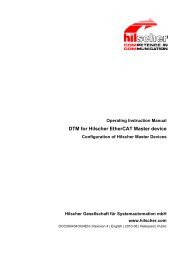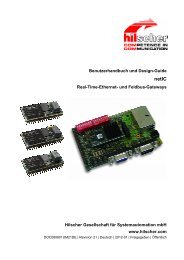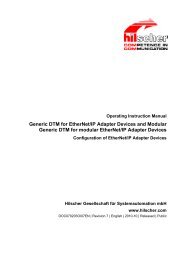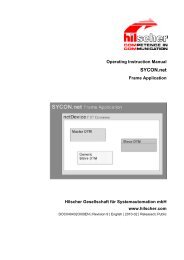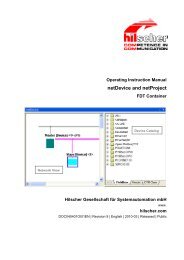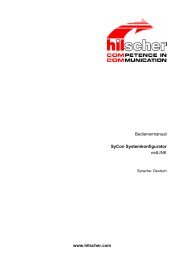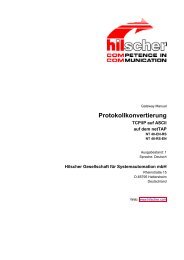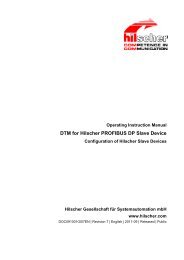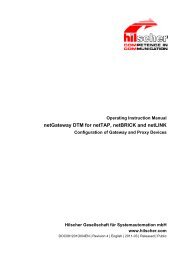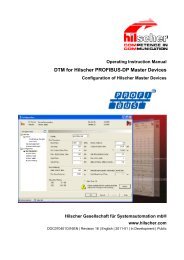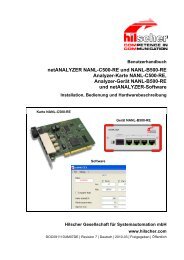SYCON.net PROFIBUS MPI DTM (Operating Instruction Manual)
SYCON.net PROFIBUS MPI DTM (Operating Instruction Manual)
SYCON.net PROFIBUS MPI DTM (Operating Instruction Manual)
You also want an ePaper? Increase the reach of your titles
YUMPU automatically turns print PDFs into web optimized ePapers that Google loves.
Configuration 49/119<br />
Parameter Meaning Range of Value/ Value<br />
Maximum Station Delay of Responders (max T<br />
Max.<br />
SDR )<br />
1 ... 1023 tBit,<br />
Station Delay This is the longest time period that must elapse before a Sender<br />
Default: 400 tBit<br />
Responder (Requestor) may send a further query telegram. Greatest time period<br />
between receipt of the last Bit of a telegram to the sending of the first Bit of<br />
a following telegram.<br />
The Sender (Requestor, Master) must wait at least for this time period<br />
after the sending of an unacknowledged telegram (e.g. Broadcast only)<br />
before a new telegram is sent.<br />
Quiet Time<br />
Setup Time<br />
Target<br />
Rotation Time<br />
GAP<br />
Actualization<br />
Factor<br />
Highest<br />
Station Address<br />
Max. Retry<br />
Limit<br />
Quiet Time (T QUI )<br />
This is the time delay that occurs for modulators (Modulator-trip time) and<br />
Repeaters (Repeater-switch time) for the change over from sending to<br />
receiving.<br />
Setup Time (T SET )<br />
Minimum period “reaction time” between the receipt of an<br />
acknowledgement to the sending of a new query telegram (Reaction) by<br />
the Sender (Requestor).<br />
Target Rotation Time (T TR )<br />
Pre-set nominal Token cycling time within the Sender authorization<br />
(Token) will cycle around the ring. How much time the Master still has<br />
available for sending data telegrams to the Slaves is dependent on the<br />
difference between the nominal and the actual token cycling time.<br />
GAP Actualization Factor (G)<br />
Factor for determining after how many Token cycles an added participant<br />
is accepted into the Token ring. After expiry of the time period G*TTR, the<br />
Station searches to see whether a further participant wishes to be<br />
accepted into the logical ring.<br />
Highest Station Address (H SA )<br />
Station address of the highest active (Master) station.<br />
Max number of telegram retries (Max_Retry_Limit)<br />
Maximum number of repetitions allowed for reaching a station.<br />
0 ... 127 tBit,<br />
Default: 1 tBit<br />
1 … 255 tBit,<br />
Default: 1 tBit<br />
>= 255 tBit,<br />
Default: 10000 tBit<br />
1 … 255,<br />
Default: 20<br />
1 … 126,<br />
Default: 31<br />
1 ... 8,<br />
Default: 1<br />
Bit times: All times for the Bus parameters are given in Bit times. The Bit time tBit is the result of the reciprocal of the<br />
Baud rate: tBit = 1 / Baud rate (Baud rate in Bit/s)<br />
The conversion from milliseconds into a Bit time is shown in the following formula:<br />
Bit time = Time [milliseconds] * Baud rate<br />
Table 18: Parameters - <strong>PROFIBUS</strong> <strong>MPI</strong><br />
<strong>DTM</strong> for Hilscher <strong>PROFIBUS</strong> <strong>MPI</strong> Devices | Configuration of Hilscher <strong>MPI</strong> Devices<br />
DOC0110402OI01EN | Revision 01 | English | 2011-07 | In Development | Public © Hilscher, 2007-2011




